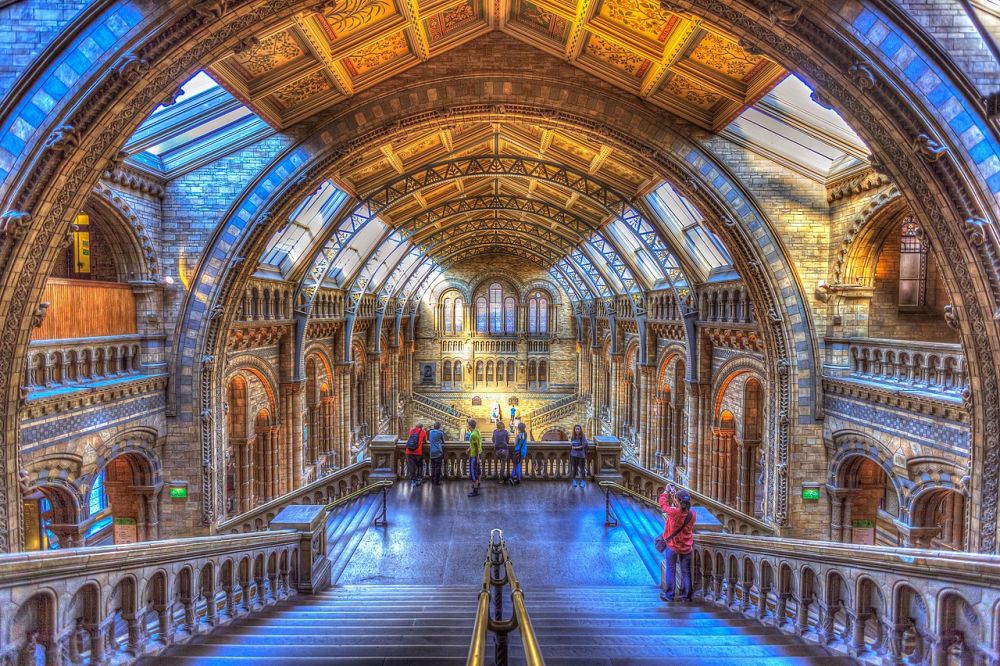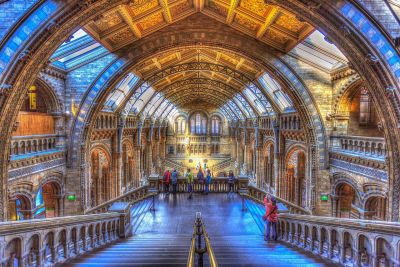

Dino Snores for Kids is an exciting sleepover event for children aged 7 to 11 at The Natural History Museum, London. It is an unforgettable night that starts with a workshop led by a science educator who will guide the children through a series of fun, educational activities. After feasting on a delicious dinner, the young explorers can partake in a dinosaur-themed scavenger hunt, explore a torch-lit trail, and get creative with arts and crafts related to natural history. Later on, they'll settle down to watch a movie before cozying up in their sleeping bags under the shadow of the museum's iconic Diplodocus skeleton or next to the blue whale model, making for a truly unique slumber party experience. In the morning, breakfast is served, and there may even be a live animal workshop before the adventure ends. It's a perfect blend of education, fun, and adventure that kids (and their accompanying adults) will remember for years to come.
The Behind-the-Scenes Tour of the Spirit Collection at The Natural History Museum gives visitors a unique opportunity to explore the collection of specimens preserved in spirit. This journey takes you through the fascinating corridors of the Darwin Centre, where you'll gain insights into the museum's scientific work. A knowledgeable guide explains the significance of these collections for research and conservation efforts, as well as sharing stories about some of the most intriguing samples, such as octopuses, giant squids, and rare specimens collected by Charles Darwin himself. The tour provides a rare glimpse into the parts of the museum not usually accessible to the public, making it a must-do for science enthusiasts and those curious about the natural world. The experience lasts about an hour and offers an intimate setting for a deeper understanding of the museum's vital work in biodiversity and conservation.
Nature Live events at The Natural History Museum are an engaging way for visitors to interact directly with scientists and learn about their latest research and discoveries. These sessions cover a variety of topics from the animal kingdom to the vastness of space, providing an up-close view of the science that helps us understand our world. During a Nature Live talk, visitors get the chance to ask real scientists questions and see specimens and objects from the museum's vast collection that aren't usually on display. It is an excellent opportunity for visitors of all ages to deepen their knowledge and foster a greater appreciation for the natural world. The duration of each talk varies, but they typically last 30 minutes and are included in the free admission to the museum, offering a valuable addition to the museum experience without additional cost.
The Wildlife Photographer of the Year Exhibition at The Natural History Museum is an awe-inspiring display of the world's best nature photography. The images showcased in this exhibit capture the splendor and fragility of the natural world in breathtaking detail. Visitors can gaze upon a variety of photographs, from intimate animal portraits to expansive landscapes, each telling its own story about the beauty and diversity of nature. The exhibition is an annual event and is highly anticipated by photographers and nature enthusiasts alike. Not only does it showcase artistic talent, but it also raises awareness about wildlife conservation and the environment. This experience typically takes about an hour to enjoy fully, offering a contemplative and visually stunning journey through the natural world. As a highlight of the museum's calendar, ticket prices may vary, so it's best to check the museum's website for the most current information.
The Volcanoes and Earthquakes Gallery at The Natural History Museum in London is a dynamic and interactive space that helps visitors understand the powerful forces of geology that shape our planet. The gallery features a variety of interactive exhibits, such as earthquake simulators and volcanic rock displays. You can immerse yourself in the stories of historic eruptions and quakes, and learn about the impacts these natural events have had on human societies. The gallery also highlights the work of scientists in understanding these geological phenomena, providing educational insights into seismology and vulcanology. This self-guided experience allows you to spend as much or as little time as you like exploring the various exhibits. It's included in the museum's free admission and suited for all ages, making it both an educational and exciting part of any visit to the museum.
The Darwin Centre Cocoon at The Natural History Museum houses millions of preserved specimens and provides a state-of-the-art home for the museum's collection, research, and staff. Visitors can peer through viewing windows to see scientists at work and interact with multimedia displays that explain the value of the collections for science and society. The cocoon is designed to be a secure and controlled environment for the long-term storage and study of delicate specimens. Visitors can learn about how scientists collect, prepare, and study various specimens from the natural world, as well as understanding the importance of these activities for conservation and biodiversity. The journey through the cocoon can take anywhere from 45 minutes to a couple of hours, depending on your level of interest in the various exhibits and interactive elements. This captivating behind-the-scenes look is included with free admission to the museum.
Coral Reefs: Secret Cities of the Sea is an immersive exhibition at The Natural History Museum that transports visitors into the heart of the world's coral reefs. This exhibition showcases the incredible diversity of life found in these vibrant underwater ecosystems and highlights the importance of coral reefs to marine life and to people around the world. Through a combination of live coral, digital displays, and stunning underwater photography, visitors can discover the complex relationships between reef inhabitants and learn about the threats facing these delicate environments, such as climate change, pollution, and overfishing. The exhibition also often features a virtual dive through a tropical reef using cutting-edge technology, enhancing the sensory experience and deepening visitor understanding of why protecting these biodiversity hotspots is so crucial. The duration of the exhibition varies based on individual interest, but it generally takes about an hour to fully enjoy all it has to offer. Prices for special exhibitions like this can vary and are in addition to the general admission fee.
Earth's Treasury at The Natural History Museum is an exhibition that reveals the beauty, rarity, and importance of the minerals and precious gems that lie beneath the Earth's surface. The display includes a varied collection of crystals, metals, and jewels, each with its own geological significance and historical context. Visitors can learn about the processes that form these treasures and the ways in which they are extracted and used by humans. The gallery provides insights into the economic, cultural, and aesthetic value of minerals and gems, as well as addressing contemporary issues such as ethical mining practices and the sustainable use of resources. Hands-on interactive exhibits, such as the earthquake simulator and dig-for-minerals stations, make this a compelling learning experience for children and adults alike. Entrance to Earth's Treasury is typically included with the free general admission, making it an enriching and accessible activity for museum-goers.
The Attenborough Studio at The Natural History Museum is named after Sir David Attenborough and serves as a hub for educational talks, film screenings, and live events that complement the museum's scientific mission. The studio is equipped with high-tech audiovisual equipment, providing an immersive learning environment. Here, visitors can attend sessions that range from discussions about the latest scientific discoveries to debates on environmental issues. The studio regularly hosts a program of interactive events often featuring live animals, enhancing the experience for those eager to learn more about the natural world. The Attenborough Studio offers a diverse schedule of educational activities suitable for all ages, blending entertainment and informative content in an intimate setting. Events in the Attenborough Studio often require a free ticket, which can be obtained from the museum on the day of the event, and typically last about 30 to 60 minutes.
The Human Evolution Gallery at The Natural History Museum traces the remarkable journey of human development over millions of years. This exhibition brings to life the story of our species, Homo sapiens, and our close relatives, through a comprehensive collection of fossil and archaeological finds. Detailed reconstructions of early humans, interactive displays, and engaging multimedia resources offer insights into how we evolved over time in response to a changing world. Visitors can learn about major milestones in human evolution, such as the development of bipedalism, the use of tools, and the advent of language and culture. The gallery also challenges visitors to contemplate the future of human evolution and the role of advances like genetic modification. As part of the museum's permanent exhibitions, the Human Evolution Gallery is free to visit and invites guests to explore at their own pace, typically spending 30 minutes to an hour immersed in our ancestral past.
